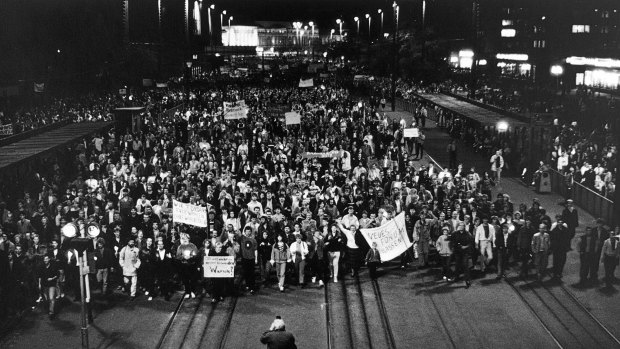“How many divisions has the Pope?” With these words to Winston Churchill late in World War II, Joseph Stalin scathingly dismissed his concerns for the Church. He would not have been so contemptuous had he survived to 1989 to see the role of Christians in bringing down the East German government and the fall of the Berlin Wall 30 years ago on November 9.

Blessed are the peacemakers: Protesters in Leipzig on October 9, 1989.Credit: Getty Images
Many factors have been credited with creating conditions for the collapse of East German communism: Mikhail Gorbachev’s new policy of openness (perestroika) in Russia, Ronald Reagan’s unrelenting hard line in the US, Pope John Paul II’s encouragement especially in Poland. All played a role.
But another vital factor was the courage of ordinary Christians, especially those who met each Monday at Leipzig’s Nikolaikirche, where Bach played the organ 275 years earlier. It started with a couple of dozen meeting for dialogue and prayer in the early 1980s and swelled steadily in 1989, filling and overflowing the church despite the presence of Stasi (secret police).
Their faith and courage was the more pronounced because East Germans were well aware of what happened at Tiananmen Square in Beijing in June, and many expected a similar response from Erich Honecker’s regime.
When, on October 9, 70,000 people of Leipzig gathered at the church demanding peaceful revolution, the government ordered some 8000 troops to open fire. But, in what is known as “the miracle of Leipzig”, they did not – and that was the end. Within a month the Berlin Wall was down, and the regime was over.
"There were two feelings," the Nikolaikirche’s Lutheran pastor, Christian Führer, said later. "One was tremendous relief that there was no Chinese solution. The other was that if 70,000 could go their own way … then East Germany was no longer the same country it had been that morning.”
In East Germany, atheism was the state religion but churches were tolerated and Führer said the church provided the only safe space. "Everything that could not be discussed in public could be discussed in church, and in this way the church represented a unique spiritual and physical space in which people were free.
"In church people had learned to turn fear into courage, to overcome the fear and to hope, to have strength.”
The lesson of the miracle of Leipzig is that violence often falters before moral power, which is one of the central teachings of Christianity’s founder. Jesus, who taught that faith has the power to move mountains, told his disciples not to return evil for evil, to love their enemies, and to pray for those who persecute them. Leipzig’s Christians found that, as Jesus promised, peacemakers are indeed blessed.
Barney Zwartz is a Senior Fellow with the Centre for Public Christianity.